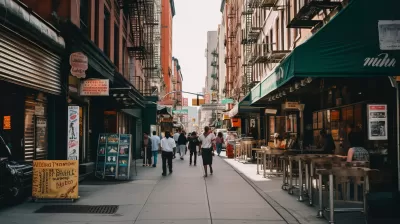While office vacancies remain high and foot traffic sparse in many U.S. downtowns, areas with housing and businesses are more vibrant and desirable than ever.

The rise of remote work during the Covid-19 pandemic has indeed shifted the center of gravity for U.S. cities, but rather than the wholesale ‘death of cities’ predicted early on, this change has simply meant that neighborhoods with mixed-use amenities are thriving while sterile, 9-to-5 business districts flounder.
Konrad Putzier and Kate King outline the phenomenon in The Wall Street Journal, writing, “Many residential neighborhoods benefit from remote work. As people spend more time at home, they frequent local shops, gyms and restaurants, boosting the economy of places such as Brooklyn, N.Y.’s Ditmas Park and Williamsburg, as well as Washington, D.C.’s Georgetown.”
Data shows visitor foot traffic is quickly rebounding to pre-pandemic levels in mixed-use, residential neighborhoods, while downtown foot traffic remains low. “Rent data, meanwhile, attests to strong demand for city living,” with rents significantly higher in desirable neighborhoods. “In the Brentwood neighborhood of Los Angeles, the median rent is up 63%.”
The authors don’t deny the challenges facing cities. “Vacant office buildings leave downtown shops and restaurants with too few customers, while falling commercial building values threaten property-tax revenues,” while “Housing shortages have pushed up rents.” But the neighborhoods with the characteristics and amenities most valued before the pandemic—walkability, access to transit, and a mix of businesses and residential uses—are continuing to draw residents eager to live there.
FULL STORY: American Cities Are Starting to Thrive Again. Just Not Near Office Buildings.

Maui's Vacation Rental Debate Turns Ugly
Verbal attacks, misinformation campaigns and fistfights plague a high-stakes debate to convert thousands of vacation rentals into long-term housing.

Planetizen Federal Action Tracker
A weekly monitor of how Trump’s orders and actions are impacting planners and planning in America.

Chicago’s Ghost Rails
Just beneath the surface of the modern city lie the remnants of its expansive early 20th-century streetcar system.

Bend, Oregon Zoning Reforms Prioritize Small-Scale Housing
The city altered its zoning code to allow multi-family housing and eliminated parking mandates citywide.

Amtrak Cutting Jobs, Funding to High-Speed Rail
The agency plans to cut 10 percent of its workforce and has confirmed it will not fund new high-speed rail projects.

LA Denies Basic Services to Unhoused Residents
The city has repeatedly failed to respond to requests for trash pickup at encampment sites, and eliminated a program that provided mobile showers and toilets.
Urban Design for Planners 1: Software Tools
This six-course series explores essential urban design concepts using open source software and equips planners with the tools they need to participate fully in the urban design process.
Planning for Universal Design
Learn the tools for implementing Universal Design in planning regulations.
planning NEXT
Appalachian Highlands Housing Partners
Mpact (founded as Rail~Volution)
City of Camden Redevelopment Agency
City of Astoria
City of Portland
City of Laramie




























